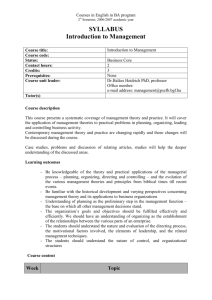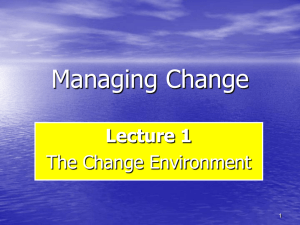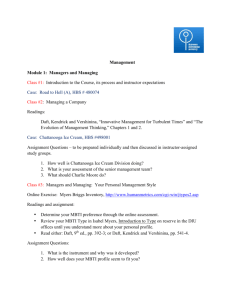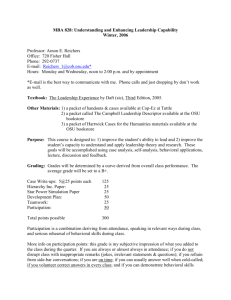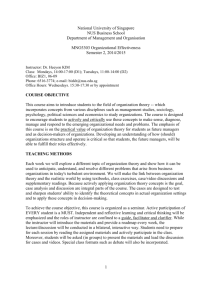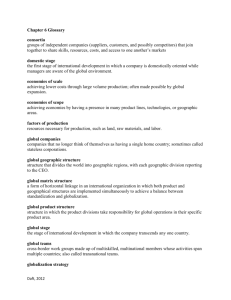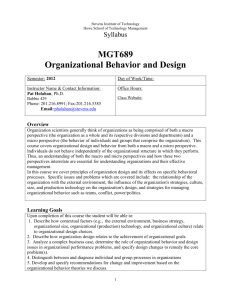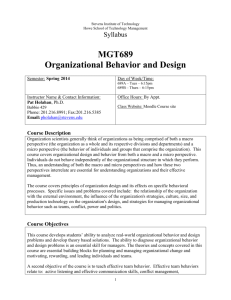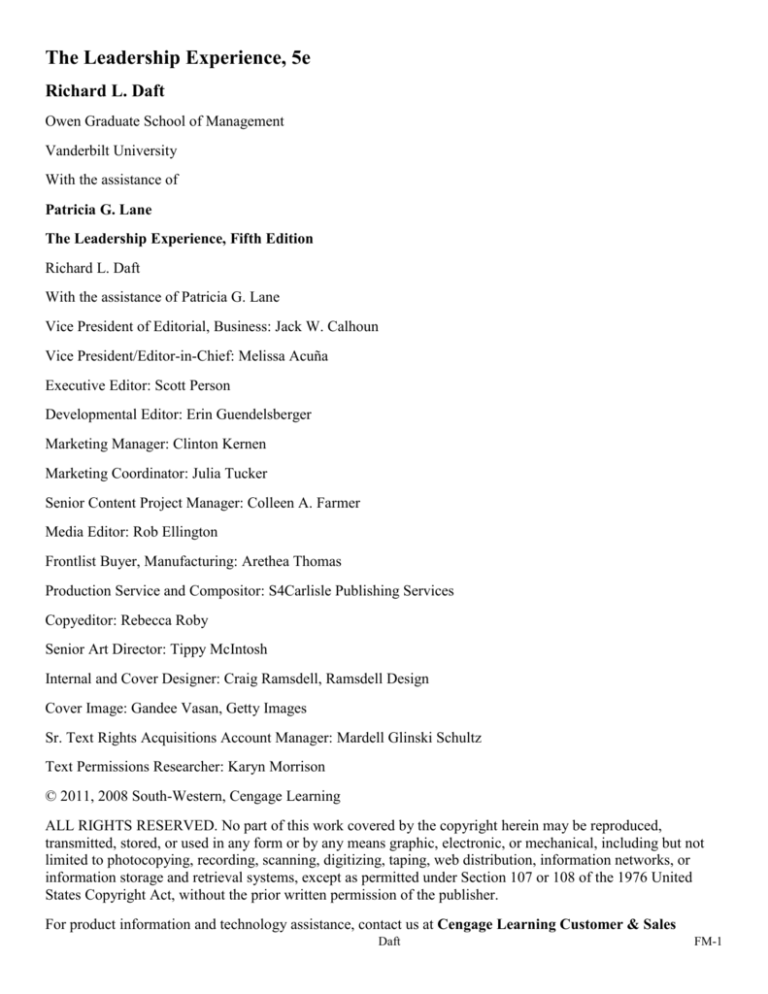
The Leadership Experience, 5e
Richard L. Daft
Owen Graduate School of Management
Vanderbilt University
With the assistance of
Patricia G. Lane
The Leadership Experience, Fifth Edition
Richard L. Daft
With the assistance of Patricia G. Lane
Vice President of Editorial, Business: Jack W. Calhoun
Vice President/Editor-in-Chief: Melissa Acuña
Executive Editor: Scott Person
Developmental Editor: Erin Guendelsberger
Marketing Manager: Clinton Kernen
Marketing Coordinator: Julia Tucker
Senior Content Project Manager: Colleen A. Farmer
Media Editor: Rob Ellington
Frontlist Buyer, Manufacturing: Arethea Thomas
Production Service and Compositor: S4Carlisle Publishing Services
Copyeditor: Rebecca Roby
Senior Art Director: Tippy McIntosh
Internal and Cover Designer: Craig Ramsdell, Ramsdell Design
Cover Image: Gandee Vasan, Getty Images
Sr. Text Rights Acquisitions Account Manager: Mardell Glinski Schultz
Text Permissions Researcher: Karyn Morrison
© 2011, 2008 South-Western, Cengage Learning
ALL RIGHTS RESERVED. No part of this work covered by the copyright herein may be reproduced,
transmitted, stored, or used in any form or by any means graphic, electronic, or mechanical, including but not
limited to photocopying, recording, scanning, digitizing, taping, web distribution, information networks, or
information storage and retrieval systems, except as permitted under Section 107 or 108 of the 1976 United
States Copyright Act, without the prior written permission of the publisher.
For product information and technology assistance, contact us at Cengage Learning Customer & Sales
Daft
FM-1
Support, 1-800-354-9706
For permission to use material from this text or product,
submit all requests online at www.cengage.com/permissions
Further permissions questions can be emailed to
permissionrequest@cengage.com
ExamView® is a registered trademark of eInstruction Corp. Windows is a registered trademark of the Microsoft
Corporation used herein under license. Macintosh and Power Macintosh are registered trademarks of Apple
Computer, Inc. used herein under license.
© 2008 Cengage Learning. All Rights Reserved.
Cengage Learning WebTutor™ is a trademark of Cengage Learning.
Library of Congress Control Number: 2009942042
ISBN-13: 978-1-4390-4211-3
ISBN-10: 1-4390-4211-X
South-Western Cengage Learning
5191 Natorp Boulevard
Mason, OH 45040
USA
Cengage Learning products are represented in Canada by
Nelson Education, Ltd.
For your course and learning solutions, visit www.cengage.com
Purchase any of our products at your local college store or at our
preferred online store www.CengageBrain.com
Printed in the United States of America
1 2 3 4 5 6 7 13 12 11 10 09
To the spiritual leaders who shaped my growth and development as a leader and as a human being.
BRIEF CONTENTS
Part 1: Introduction to Leadership
1
1. What Does It Mean to Be a Leader? 2
Part 2: Research Perspectives on Leadership
35
2. Traits, Behaviors, and Relationships 36
3. Contingency Approaches to Leadership 64
FM-2
Daft
Part 3: The Personal Side of Leadership
97
4. The Leader as an Individual 98
5. Leadership Mind and Heart 132
6. Courage and Moral Leadership 164
7. Followership 194
Part 4: The Leader as a Relationship Builder
223
8. Motivation and Empowerment 224
9. Leadership Communication 260
10. Leading Teams 292
11. Developing Leadership Diversity 328
12. Leadership Power and Influence 360
Part 5: The Leader as Social Architect
393
13. Creating Vision and Strategic Direction 394
14. Shaping Culture and Values 426
15. Leading Change 456
Name Index 491
Index of Organizations 495
Subject Index 499
CONTENTS
Part 1: Introduction to Leadership 1
Chapter 1: What Does It Mean to Be a Leader? 2
The Nature of Leadership 4
Definition of Leadership 5
Leadership and the Business of Living 6
The New Reality for Today’s Organizations 7
From Stability to Change and Crisis Management 8
From Control to Empowerment 9
From Competition to Collaboration 9
Leader’s Bookshelf 10
Leader’s Self-Insight 1.1 11
Daft
FM-3
From Uniformity to Diversity 12
From Self-Centered to Higher Ethical Purpose 12
Consider This! 13
From Hero to Humble 13
In the Lead 13
Leadership and the Wall Street Meltdown 14
Comparing Management and Leadership 15
Providing Direction 15
Aligning Followers 16
Building Relationships 16
Leader’s Self-Insight 1.2 17
Developing Personal Leadership Qualities 18
In the Lead 18
Creating Outcomes 19
Evolving Theories of Leadership 19
Historical Overview of Major Approaches 19
A Model of Leadership Evolution 20
Leadership Is Intentional 22
Leader’s Self-Insight 1.3 24
Learning the Art and Science of Leadership 25
Organization of the Rest of the Book 26
Leadership Essentials 27
Discussion Questions 28
Leadership at Work 28
Leadership Right–Wrong 28
Leadership Development: Cases for Analysis 29
Sales Engineering Division 29
Studer International 30
References 31
Part 2: Research Perspectives on Leadership 35
FM-4
Daft
Chapter 2: Traits, Behaviors, and Relationships 36
Know Your Strengths 38
The Trait Approach 38
Leader’s Bookshelf 39
Leader’s Self-Insight 2.1 41
In the Lead 43
Behavior Approaches 43
Consider This! 44
Autocratic versus Democratic Leadership 44
In the Lead 45
Ohio State Studies 46
Leader’s Self-Insight 2.2 47
In the Lead 47
University of Michigan Studies 48
The Leadership Grid 49
In the Lead 50
Theories of a “High-High” Leader 50
Individualized Leadership 51
Vertical Dyad Linkage Model 52
Leader–Member Exchange 53
Partnership Building 53
Leader’s Self-Insight 2.3 54
Entrepreneurial Leadership 55
Matching Leaders with Roles 55
Leadership Essentials 57
Discussion Questions 57
Leadership at Work 58
Your Ideal Leader Traits 58
Leadership Development: Cases for Analysis 59
Consolidated Products 59
Daft
FM-5
D. L. Woodside, Sunshine Snacks 60
References 61
Chapter 3: Contingency Approaches to Leadership 64
The Contingency Approach 66
Leader’s Bookshelf 67
Fiedler’s Contingency Model 68
Leader’s Self-Insight 3.1 69
Leadership Style 69
Situation 70
Contingency Theory 70
In the Lead 72
Hersey and Blanchard’s Situational Theory 73
Leader Style 73
Follower Readiness 73
Leader’s Self-Insight 3.2 76
In the Lead 77
Path–Goal Theory 77
Leader Behavior 78
In the Lead 79
Consider This! 80
Situational Contingencies 80
Use of Rewards 81
The Vroom–Jago Contingency Model 82
Leader Participation Styles 82
Diagnostic Questions 83
Selecting a Decision Style 84
In the Lead 87
Substitutes for Leadership 88
Leader’s Self-Insight 3.3 90
Leadership Essentials 91
FM-6
Daft
Discussion Questions 91
Leadership at Work 92
Task versus Relationship Role Play 92
Leadership Development: Cases for Analysis 93
Alvis Corporation 93
Finance Department 94
References 95
CONTENTS
Part 3: The Personal Side of Leadership 97
Chapter 4: The Leader as an Individual 98
Personality and Leadership 100
A Model of Personality 100
Leader’s Self-Insight 4.1 101
In the Lead 102
Personality Traits and Leader Behavior 104
In the Lead 105
Leader’s Self-Insight 4.2 106
Values and Attitudes 107
Instrumental and End Values 107
Leader’s Self-Insight 4.3 108
Consider This! 109
In the Lead 109
How Attitudes Affect Leadership 110
Leader’s Bookshelf 111
Social Perception and Attribution Theory 112
Perceptual Distortions 113
Attribution Theory 114
In the Lead 115
Cognitive Differences 116
Patterns of Thinking and Brain Dominance 116
Daft
FM-7
Leader’s Self-Insight 4.4 117
In the Lead 119
Problem-Solving Styles: The Myers–Briggs Type Indicator 119
Working with Different Personality Types 121
Leader’s Self-Insight 4.5 122
Leadership Essentials 125
Discussion Questions 125
Leadership at Work 126
Past and Future 126
Leadership Development: Cases for Analysis 127
International Bank 127
Environmental Designs International 128
References 130
Chapter 5: Leadership Mind and Heart 132
Leader Capacity versus Competence 134
Mental Models 135
Assumptions 136
In the Lead 136
Changing Mental Models 137
Developing a Leader’s Mind 138
Independent Thinking 138
Leader’s Bookshelf 139
Open-Mindedness 140
Leader’s Self-Insight 5.1 141
Consider This! 142
Systems Thinking 142
Personal Mastery 144
Emotional Intelligence—Leading with Heart and Mind 145
What Are Emotions? 146
The Components of Emotional Intelligence 147
FM-8
Daft
In the Lead 149
Leader’s Self-Insight 5.2 150
The Emotionally Competent Leader 150
The Emotional Intelligence of Teams 152
Leading with Love versus Leading with Fear 152
Leader’s Self-Insight 5.3 153
Fear in Organizations 153
Bringing Love to Work 154
In the Lead 156
Why Followers Respond to Love 156
Leadership Essentials 157
Discussion Questions 158
Leadership at Work 158
Mentors 158
Leadership Development: Cases for Analysis 159
The New Boss 159
The USS Florida 160
References 161
Chapter 6: Courage and Moral Leadership 164
Moral Leadership Today 166
The Ethical Climate in U.S. Business 167
What Leaders Do to Make Things Go Wrong 167
Leader’s Self-Insight 6.1 169
Acting Like a Moral Leader 170
In the Lead 171
Becoming a Moral Leader 172
Servant Leadership 174
Authoritarian Management 175
Participative Management 175
Stewardship 175
Daft
FM-9
The Servant Leader 176
In the Lead 177
Leader’s Self-Insight 6.2 179
Leadership Courage 180
What Is Courage? 180
Consider This! 180
In the Lead 182
Leader’s Self-Insight 6.3 183
How Does Courage Apply to Moral Leadership? 184
Finding Personal Courage 185
Leader’s Bookshelf 186
Leadership Essentials 187
Discussion Questions 188
Leadership at Work 189
Scary Person 189
Leadership Development: Cases for Analysis 189
Sycamore Pharmaceuticals 189
The Boy, the Girl, the Ferryboat Captain, and the Hermits 190
References 191
Chapter 7: Followership 194
The Role of Followers 196
In the Lead 196
Styles of Followership 197
Leader’s Self-Insight 7.1 199
In the Lead 200
Demands on the Effective Follower 201
Consider This! 201
In the Lead 203
Developing Personal Potential 203
From Dependence to Independence 204
FM-10
Daft
Effective Interdependence 205
What Leaders Want from Followers 206
Leader’s Bookshelf 207
Strategies for Managing Up 207
Leader’s Self-Insight 7.2 208
Be a Resource for the Leader 209
Help the Leader Be a Good Leader 210
Build a Relationship with the Leader 210
In the Lead 210
View the Leader Realistically 211
What Followers Want from Leaders 211
Clarity of Direction 212
Frequent, Specific, and Immediate Feedback 212
Leader’s Self-Insight 7.3 213
Coaching to Develop Potential 215
Leadership Essentials 217
Discussion Questions 218
Leadership at Work 218
Follower Role Play 218
Leadership Development: Cases for Analysis 219
General Products Britain 219
Jake’s Pet Land 220
References 221
Chapter 8: Motivation and Empowerment 224
Leadership and Motivation 226
Intrinsic and Extrinsic Rewards 227
Higher versus Lower Needs 228
Needs-Based Theories of Motivation 229
Hierarchy of Needs Theory 229
Two-Factor Theory 230
Daft
FM-11
Leader’s Self-Insight 8.1 232
In the Lead 232
Acquired Needs Theory 233
Other Motivation Theories 234
Reinforcement Perspective on Motivation 234
Expectancy Theory 235
In the Lead 237
Equity Theory 237
Leader’s Self-Insight 8.2 238
The Carrot-and-Stick Controversy 239
In the Lead 240
Consider This! 242
Empowering People to Meet Higher Needs 243
Elements of Empowerment 243
Empowerment Applications 244
Leader’s Self-Insight 8.3 246
Employee Engagement Programs 246
Giving Meaning to Work Through Engagement 246
Leader’s Bookshelf 248
In the Lead 248
Other Approaches 249
Leadership Essentials 251
Discussion Questions 252
Leadership at Work 253
Should, Need, Like, Love 253
Leadership Development: Cases for Analysis 254
Montego Bay 254
Cub Scout Pack 81 255
References 256
Chapter 9: Leadership Communication 260
FM-12
Daft
How Leaders Communicate 262
Management Communication 263
Leader’s Self-Insight 9.1 264
The Leader as Communication Champion 265
Consider This! 265
Leading Strategic Conversations 266
Creating an Open Communication Climate 267
In the Lead 267
Asking Questions 268
Listening 269
Leader’s Self-Insight 9.2 270
Discerning Hot Topics 270
In the Lead 271
Dialogue 272
The Johari Window 273
Leader’s Bookshelf 274
Communicating to Persuade and Influence 276
Selecting Rich Communication Channels 277
The Continuum of Channel Richness 277
Leader’s Self-Insight 9.3 279
Effectively Using Electronic Communication Channels 280
In the Lead 280
Nonverbal Communication 281
Communicating in a Crisis 283
In the Lead 284
Leadership Essentials 285
Discussion Questions 285
Leadership at Work 286
Listen Like a Professional 286
Leadership Development: Cases for Analysis 287
Daft
FM-13
The Superintendent’s Directive 287
The Saddle Creek Deli 288
References 290
Chapter 10: Leading Teams 292
Teams in Organizations 294
What Is a Team? 294
Consider This! 295
The Dilemma of Teams 296
Leader’s Bookshelf 297
How Teams Develop 298
Team Types and Characteristics 299
Traditional Types of Teams 300
In the Lead 300
Understanding Team Characteristics 303
In the Lead 304
Team Effectiveness 305
Team Cohesiveness and Effectiveness 306
Leader’s Self-Insight 10.1 307
Meeting Task and Socioemotional Needs 307
The Team Leader’s Personal Role 308
Recognize the Importance of Shared Purpose and Values 309
Build Consensus 309
Admit Your Mistakes 309
Leader’s Self-Insight 10.2 310
Provide Support and Coaching to Team Members 310
The Leader’s New Challenge: Virtual and Global Teams 311
Virtual Teams 312
In the Lead 313
Global Teams 314
Handling Team Conflict 315
FM-14
Daft
Causes of Conflict 316
In the Lead 316
Styles to Handle Conflict 317
Other Approaches 318
Leader’s Self-Insight 10.3 319
Leadership Essentials 320
Discussion Questions 321
Leadership at Work 321
Team Feedback 321
Leadership Development: Cases for Analysis 322
Valena Scientific Corporation 322
Devereaux-Dering Group 324
References 325
Chapter 11: Developing Leadership Diversity 328
Leading People Who Aren’t Like You 330
Leader’s Self-Insight 11.1 331
Diversity Today 331
Definition of Diversity 332
Changing Attitudes Toward Diversity 333
In the Lead 333
The Value of Organizational Diversity 333
Consider This! 335
Challenges Minorities Face 335
Leader’s Self-Insight 11.2 336
Prejudice, Stereotypes, and Discrimination 336
Unequal Expectations 337
The Glass Ceiling 338
Leader’s Bookshelf 339
The Opportunity Gap 340
In the Lead 340
Daft
FM-15
Ways Women Lead 341
Women as Leaders 341
Is Leader Style Gender-Driven? 342
In the Lead 343
Global Diversity 344
The Sociocultural Environment 344
Leader’s Self-Insight 11.3 345
Social Value Systems 346
Developing Cultural Intelligence 347
Leadership Implications 348
Becoming an Inclusive Leader 349
Stages of Personal Diversity Awareness 349
Ways to Enhance Personal Diversity Awareness 350
Personal Qualities for Leading Diverse People 351
In the Lead 352
Leadership Essentials 353
Discussion Questions 353
Leadership at Work 354
Personal Diversity 354
Leadership Development: Cases for Analysis 355
Northern Industries 355
The Trouble with Bangles 356
References 357
Chapter 12: Leadership Power and Influence 360
Three Kinds of Influential Leadership 362
Transformational Leadership 362
Charismatic Leadership 364
Coalitional Leadership 365
Leader’s Self-Insight 12.1 366
Leader’s Self-Insight 12.2 367
FM-16
Daft
In the Lead 367
Power, Influence, and Leadership 369
Hard Versus Soft Power 369
In the Lead 371
Follower Responses to the Use of Power 372
Consider This! 372
Sources of Leader Power 373
Dependency 373
Control over Resources 374
Control over Information 375
Increasing Power Through Political Activity 375
Leader Frames of Reference 376
Political Tactics for Asserting Leader Influence 377
Leader’s Self-Insight 12.3 378
Leader’s Bookshelf 379
In the Lead 381
In the Lead 382
Ethical Considerations in Using Power and Politics 383
Leadership Essentials 384
Discussion Questions 385
Leadership at Work 386
Circle of Influence 386
Leadership Development: Cases for Analysis 387
The Unhealthy Hospital 387
Waite Pharmaceuticals 388
References 389
Part 5: The Leader as Social Architect 393
Chapter 13: Creating Vision and Strategic Direction 394
Strategic Leadership 396
Leadership Vision 397
Daft
FM-17
Leader’s Self-Insight 13.1 398
What Vision Does 400
Leader’s Self-Insight 13.2 401
In the Lead 402
Common Themes of Vision 402
Consider This! 403
A Vision Works at Multiple Levels 404
In the Lead 404
Mission 405
What Mission Does 406
Leader’s Bookshelf 407
A Framework for Noble Purpose 408
In the Lead 409
Strategy in Action 410
Deciding How to Achieve the Vision 410
Deciding How to Execute 412
The Leader’s Contribution 414
In the Lead 414
Stimulating Vision and Action 415
Leader’s Self-Insight 13.3 416
How Leaders Decide 417
Leadership Essentials 418
Discussion Questions 418
Leadership at Work 419
Future Thinking 419
Leadership Development: Cases for Analysis 421
Metropolis Police Department 421
The Visionary Leader 421
References 423
Chapter 14: Shaping Culture and Values 426
FM-18
Daft
Organizational Culture 428
What Is Culture? 428
Leader’s Self-Insight 14.1 430
Importance of Culture 430
In the Lead 431
Consider This! 432
Culture Strength, Adaptation, and Performance 432
Adaptive Cultures 433
The High-Performance Culture 434
Leader’s Self-Insight 14.2 435
Cultural Leadership 436
Ceremonies 437
Stories 437
Symbols 438
Specialized Language 438
Selection and Socialization 438
Daily Actions 439
The Competing Values Approach to Shaping Culture 440
Adaptability Culture 440
In the Lead 441
Leader’s Self-Insight 14.3 442
Achievement Culture 443
Clan Culture 443
Leader’s Bookshelf 444
Bureaucratic Culture 444
Ethical Values in Organizations 445
In the Lead 445
Values-Based Leadership 446
Personal Ethics 446
Spiritual Values 447
Daft
FM-19
Leader’s Self-Insight 14.4 448
In the Lead 450
Leadership Essentials 451
Discussion Questions 452
Leadership at Work 452
Walk the Talk 452
Leadership Development: Cases for Analysis 453
Lisa Benavides, Forest International 453
5 Star and Amtech 455
References 456
Chapter 15: Leading Change 458
Change or Perish 460
In the Lead 461
Leader’s Self-Insight 15.1 462
A Framework for Leading Change 462
Appreciative Inquiry 465
Leader’s Self-Insight 15.2 466
Leading a Major Change 466
Leading Everyday Change 468
In the Lead 468
Leading for Innovation 469
The Creative Organization 469
Leader’s Bookshelf 472
Leading Creative People 472
Leader’s Self-Insight 15.3 474
Implementing Change 478
Consider This! 478
Tools for Implementation 479
In the Lead 480
The Two Faces of Change 481
FM-20
Daft
Leadership and Downsizing 481
Leadership Essentials 482
Discussion Questions 483
Leadership at Work 483
Organizational Change Role Play 483
Leadership Development: Cases for Analysis 485
American Tool & Die 485
Riverside Pediatric Associates 486
References 488
Name Index 491
Index of Organizations 495
Subject Index 499
ABOUT THE AUTHOR
Richard L. Daft, Ph.D., is the Brownlee O. Currey, Jr., Professor of Management in the Owen Graduate School
of Management at Vanderbilt University. Professor Daft specializes in the study of leadership and organization
theory. Dr. Daft is a Fellow of the Academy of Management and has served on the editorial boards of Academy
of Management Journal, Administrative Science Quarterly, and Journal of Management Education. He was the
Associate Editor-in-Chief of Organization Science and served for three years as Associate Editor of
Administrative Science Quarterly.
Professor Daft has authored or coauthored 13 books, including Organization Theory and Design (SouthWestern, 2010), Management (South-Western, 2010), and What to Study: Generating and Developing Research
Questions (Sage, 1982). He coauthored, with Robert Lengel, Fusion Leadership: Unlocking the Subtle Forces
That Change People and Organizations (Berrett-Koehler, 2000). His most recent book, The Executive and the
Elephant, will be available in 2010 (Jossey-Bass). He has also authored dozens of scholarly articles, papers, and
chapters. His work has been published in Administrative Science Quarterly, Academy of Management Journal,
Academy of Management Review, Strategic Management Journal, Journal of Management, Accounting
Organizations and Society, Management Science, MIS Quarterly, California Management Review, and
Organizational Behavior Teaching Review. Professor Daft has been awarded several government research
grants to pursue studies of organization design, organizational innovation and change, strategy implementation,
and organizational information processing.
Dr. Daft also is an active teacher and consultant. He has taught management, leadership, organizational
change, organizational theory, and organizational behavior. He has served as associate dean, produced for-profit
theatrical productions, and helped manage a start-up enterprise. He has been involved in management
development and consulting for many companies and government organizations including the American
Banking Association, AutoZone, Bell Canada, Nortel, Bridgestone, TVA, Pratt & Whitney, Allstate Insurance,
State Farm Insurance, the United States Air Force, the U.S. Army, J. C. Bradford & Co., Central Parking
System, USAA, Bristol-Myers Squibb, First American National Bank, and the Vanderbilt University Medical
Center.
PREFACE
Daft
FM-21
Many leaders have recently had their assumptions challenged about how organizations work. The crisis in the
housing, mortgage, and finance industries and resulting recession, the failures of several large long-standing
organizations and the government bailout of others, volatile oil prices, ethical scandals, political turmoil, and
other events have dramatically shifted the organizational and economic landscape. Leaders are struggling to
make sense of the shifting environment and learn how to lead effectively and successfully in the midst of
turmoil. This edition of The Leadership Experience addresses themes and issues that are directly relevant to the
current turbulent environment. My vision for the fifth edition is to give students an exciting, applied, and
comprehensive view of what leadership is like in today’s world. The Leadership Experience integrates recent
ideas and applications with established scholarly research in a way that makes the topic of leadership come
alive. Organizations are undergoing major changes, and this textbook addresses the qualities and skills leaders
need in this rapidly evolving world.
Recent chaotic events, combined with factors such as a growing need for creativity and innovation in
organizations, the emergence of e-business, the use of virtual teams, globalization, and other ongoing
transformations, place new demands on leaders that go far beyond the topics traditionally taught in courses on
management or organizational behavior. My experiences teaching leadership to students and managers, and
working with leaders to change their organizations, have affirmed for me the value of traditional leadership
concepts, while highlighting the importance of including new ideas and applications.
The Leadership Experience thoroughly covers the history of leadership studies and the traditional theories,
but goes beyond that to incorporate valuable ideas such as leadership vision, shaping culture and values,
leadership courage, and the importance of moral leadership. The book expands the treatment of leadership to
capture the excitement of the subject in a way that motivates students and challenges them to develop their
leadership potential.
New to the Fifth Edition
A primary focus for revising The Leadership Experience, fifth edition, has been to relate leadership concepts
and theories to events in today’s turbulent environment. Each chapter has been thoroughly revised and updated
to bring in current issues that leaders face. Sections that are particularly relevant to fast-shifting current events
have been marked with a “Turbulent Times” icon.
Topics that have been added or expanded in the fifth edition include the Wall Street meltdown; developing
leadership courage as a skill; appreciative inquiry; soft versus hard power; leadership coaching; operational,
collaborative, and advisory leadership roles; coalitional leadership; understanding one’s leadership strengths;
entrepreneurial leadership; leading diverse people and people with varied personalities; enhancing emotional
intelligence; the Johari Window framework; nonverbal communication; the dilemma of teamwork; the team
leader’s role in shaping norms; leading virtual teams; leader frames of reference; open innovation; and building
ethical corporate cultures. The book also includes several new cases for analysis that are related to current
issues.
The Leadership Experience continues to offer students great opportunities for self-assessment and
leadership development. An important aspect of learning to be a leader involves looking inward for greater selfunderstanding, and the fifth edition provides numerous opportunities for this reflection. Each chapter includes
multiple questionnaires or exercises that enable students to learn about their own leadership beliefs, values,
competencies, and skills. These exercises help students gauge their current standing and connect the chapter
concepts and examples to ideas for expanding their own leadership abilities. A few of the self-assessment topics
are innovation, networking, personality traits, leading diverse people, developing a personal vision, spiritual
leadership, leadership courage, and leading with love versus leading with fear. Self-assessments related to basic
leadership abilities such as listening skills, emotional intelligence, motivating others, and using power and
influence are also included.
Organization
FM-22
Daft
The organization of the book is based on first understanding basic ways in which leaders differ from managers,
and the ways leaders set direction, seek alignment between organizations and followers, build relationships, and
create change. Thus the organization of this book is in five parts:
1. Introduction to Leadership
2. Research Perspectives on Leadership
3. The Personal Side of Leadership
4. The Leader as a Relationship Builder
5. The Leader as Social Architect
The book integrates materials from both micro and macro approaches to leadership, from both academia and the
real world, and from traditional ideas and recent thinking.
Distinguishing Features
This book has a number of special features that are designed to make the material accessible and valuable to
students.
Turbulent Times This new feature calls attention to examples, book reviews, or topics that are related to
current issues leaders face in today’s fast-shifting and uncertain world.
In the Lead The Leadership Experience is loaded with new examples of leaders in both traditional and
contemporary organizations. Each chapter opens with a real- life example that relates to the chapter content, and
several additional examples are highlighted within each chapter. These spotlight examples are drawn from a
wide variety of organizations including education, the military, government agencies, businesses, and nonprofit
organizations.
Consider This! Each chapter contains a Consider This! box that is personal, compelling, and inspiring. This
box may be a saying from a famous leader, or wisdom from the ages. These Consider This! boxes provide novel
and interesting material to expand the reader’s thinking about the leadership experience.
Leader’s Bookshelf Each chapter also includes a review of a recent book relevant to the chapter’s content. The
Leader’s Bookshelf connects students to issues and topics being read and discussed in the worlds of academia,
business, military, education, and nonprofit organizations.
Action Memo This margin feature helps students apply the chapter concepts in their own lives and leadership
activities, as well as directs students to self-assessments related to various chapter topics.
Leader’s Self-Insight boxes provide self-assessments for learners and an opportunity to experience leadership
issues in a personal way. These exercises take the form of questionnaires, scenarios, and activities.
Student Development Each chapter ends with Discussion Questions and then two activities for student
development. The first, Leadership at Work, is a practical, skill-building activity that engages the student in
applying chapter concepts to real-life leadership. These exercises are designed so students can complete them
on their own outside of class or in class as part of a group activity. Instructor tips are given for maximizing inclass learning with the Leadership at Work exercises. Leadership Development—Cases for Analysis, the
second end-of-chapter activity, provides two short, problem-oriented cases for analysis. These cases test the
student’s ability to apply concepts when dealing with real-life leadership issues. The cases challenge the
student’s cognitive understanding of leadership ideas while the Leadership at Work exercises and the feedback
questionnaires assess the student’s progress as a leader.
Ancillaries
Daft
FM-23
This edition offers a wider range than previous editions of instructor ancillaries to fully enable instructors to
bring the leadership experience into the classroom. These ancillaries include:
Instructor’s Manual with Test Bank (ISBN: 1-1110-5882-2)
A comprehensive Instructor’s Manual and Test Bank is available to assist in lecture preparation. Included in the
Instructor’s Manual are the chapter outlines, suggested answers to end-of-chapter materials, and suggestions for
further study. The Test Bank includes approximately 60 questions per chapter to assist in writing examinations.
Types of questions include true/false, multiple choice, completion, short-answer, and essay. For this edition,
we’ve doubled the number of multiple-choice questions.
Instructor’s Resource CD-ROM (ISBN: 1-1110-5881-4)
Key instructor ancillaries (Instructor’s Manual, Test Bank, ExamView, and PowerPoint slides) are provided on
CD-ROM, giving instructors the ultimate tool for customizing lectures and presentations.
ExamView
Available on the Instructor’s Resource CD, ExamView contains all of the questions in the printed test bank.
This program is an easy-to-use test creation software compatible with Windows or Macintosh. Instructors can
add or edit questions, instructions, and answers, and select questions (randomly or numerically) by previewing
them on the screen.
PowerPoint Lecture Presentation
An asset to any instructor, the lectures provide outlines for every chapter, graphics of the illustrations from the
text, and additional examples providing instructors with a number of learning opportunities for students.
Videos (ISBN: 0-538-46970-6)
Videos compiled specifically to accompany The Leadership Experience, fifth edition, use real-world companies
to illustrate international business concepts as outlined in the text. Focusing on both small and large businesses,
the videos give students an inside perspective on the situations and issues that global corporations face.
Companion Web site (www.cengage.com/management/daft)
The Leadership Experience’s Web site provides a multitude of resources for both instructors and students.
Premium Web site (www.cengage.com/login)
This new optional Premium Web site features text-specific resources that enhance student learning by bringing
concepts to life. Dynamic interactive learning tools include online quizzes, flashcards, PowerPoint slides,
learning games, and more.
Acknowledgments
Textbook writing is a team enterprise. This book has integrated ideas and support from many people whom I
want to acknowledge. I want to extend special thanks to my editorial associate, Pat Lane. I could not have
undertaken this revision without Pat’s help. She skillfully drafted materials for the chapters, found original
sources, and did an outstanding job with last-minute changes, the copyedited manuscript, art, and galley proofs.
Pat’s talent and personal enthusiasm for this text added greatly to its excellence.
Here at Vanderbilt I want to thank my assistant, Barbara Haselton, for the tremendous volume and quality of
work she accomplished on my behalf that gave me time to write. Jim Bradford, the Dean at Owen, and Dawn
Iacobucci, the Senior Associate Dean, have maintained a positive scholarly atmosphere and supported me with
the time and resources to complete the revision of this book. I also appreciate the intellectual stimulation and
FM-24
Daft
support from friends and colleagues at the Owen School—Bruce Barry, Ray Friedman, Neta Moye, Rich
Oliver, David Owens, Ranga Ramanujam, Bart Victor, and Tim Vogus.
I want to acknowledge the reviewers who provided feedback. Their ideas helped me improve the book in
many areas:
Thomas H. Arcy
Janey Ayres
University of Houston—Central Campus
Purdue University
Kristin Backhaus
Bill Bommer
SUNY New Paltz
Georgia State University
William Russell Brown
Jared Caughron
Navarro College
University of Oklahoma
Glenn K. Cunningham
Ron Franzen
Duquesne University
Saint Luke’s Hospital
Delia J. Haak
Nell Hartley
John Brown University
Robert Morris College
Ann Horn-Jeddy
Ellen Jordan
Medaille College
Mount Olive College
Gregory Manora
Joseph Martelli
Auburn University–Montgomery
The University of Findlay
Richard T. Martin
Mark Nagel
Washburn University
Normandale Community College
Ranjna Patel
Chad Peterson
Bethune Cookman College
Baylor University
Gordon Riggles
Bill Service
University of Colorado
Samford University
Dan Sherman
Bret Simmons
University of Alabama at Huntsville
North Dakota State University
Shane Spiller
Shand H. Stringham
University of Montevallo
Duquesne University
Ahmad Tootonchi
Mary L. Tucker
Frostburg State University
Ohio University
Joseph W. Weiss
Xavier Whitaker
Daft
FM-25
Bentley University
Baylor University
Donald D. White
Jean Wilson
University of Arkansas
The College of William and Mary
George A. Wynn
University of Tampa
The editors at South-Western also deserve special mention. Scott Person and Joe Sabatino, Executive
Editors, supported the concept for this book and obtained the resources necessary for its completion. Erin
Guendelsberger, Developmental Editor, provided terrific support for the book’s writing, reviews, and
production. Colleen Farmer, Senior Content Project Manager, smoothly took the book through the production
process. Tippy McIntosh, Art Director, created the design for the fifth edition. Clinton Kernen, Marketing
Manager, led the marketing efforts for the book.
I also thank Bob Lengel, at the University of Texas at San Antonio. Bob’s enthusiasm for leadership many
years ago stimulated me to begin reading, teaching, and training in the area of leadership development. His
enthusiasm also led to our collaboration on the book Fusion Leadership: Unlocking the Subtle Forces That
Change People and Organizations. I thank Bob for keeping our shared leadership dream alive, which in time
enabled me to pursue my dream of writing this leadership textbook.
Finally, I want to acknowledge my loving family. I received much love and support from my wife, Dorothy
Marcic, and daughters Danielle, Amy, Roxanne, Solange, and Elizabeth. Although everyone is now pursuing
their own lives and careers, I appreciate the good feelings and connections with my children and grandchildren.
On occasion, we have been able to travel, ski, watch a play, or just be together—all of which reconnect me to
the things that really count.
FM-26
Daft

